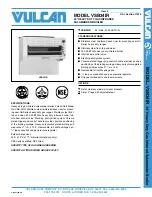
GWA
Gas-Fired Water Boilers –
Boiler Manual
4
Part Number 670 01 1001 00
1
Prepare boiler location
continued
Failure to follow all instructions can result in flue gas
spillage and carbon monoxide emissions, causing
severe personal injury or death.
When removing boiler from existing common vent
system:
At the time of removal of an existing boiler, the following steps shall
be followed with each appliance remaining connected to the common
venting system placed in operation, while the other appliances
remaining connected to the common venting system are not in
operation.
a. Seal any unused openings in the common venting system.
b.
Visually inspect the venting system for proper size and horizontal
pitch and determine there is no blockage or restriction, leakage,
corrosion or other deficiencies which could cause an unsafe
condition.
c. Test vent system — Insofar as is practical, close all building
doors and windows and all doors between the space in which
the appliances remaining connected to the common venting
system are located and other spaces of the building. Turn on
clothes dryers and any appliance not connected to the common
venting system. Turn on any exhaust fans, such as range hoods
and bathroom exhausts, so they will operate at maximum speed.
Do not operate a summer exhaust fan. Close fireplace dampers.
d. Place in operation the appliance being inspected. Follow the
lighting/operating instructions. Adjust thermostat so appliance
will operate continuously.
e. Test for spillage at draft hood relief opening after 5 minutes of
main burner operation. Use the flame of a match or candle.
f.
After it has been determined that each appliance remaining
connected to the common venting system properly vents when
tested as outlined above, return doors, windows, exhaust fans,
fireplace dampers, and any other gas-burning appliance to their
previous conditions of use.
Any improper operation of common venting system should be
corrected so the installation conforms with the National Fuel Gas
Code, ANSI Z223.1–latest edition. Correct by resizing to approach
the minimum size as determined using the appropriate tables in
Part 11 of that code. Canadian installations must comply with B149.1
or B149.2 Installation Code.
Chimney or vent requirements
1. Venting must be installed according to Part 7, “Venting of
Do not alter boiler draft hood or place any obstruction
or non-certified vent damper in breeching or vent
system. CSA certification will become void. Flue gas
spillage and carbon monoxide emissions will occur
causing severe personal injury or death.
Inspect existing chimney before installing boiler.
Failure to clean or replace perforated pipe or tile lining
will cause severe personal injury or death.
Vent system
Equipment”, of National Fuel Gas Code, ANSI Z223.1–latest
edition and applicable building codes. Canadian installations
must comply with B149.1 or B149.2 Installation Codes.
2. See “Ratings” on page 35 for minimum chimney or vent sizes.
Chimney or vent termination:
•
A chimney, or any vent other than a Type B vent with listed
vent cap, must extend at least 3 feet above the highest point
where it passes through a roof of a building, and at least
2 feet higher than any portion of a building within a horizontal
distance of 10 feet.
•
Type B vents with listed caps may terminate as in Figure 2
if no closer than 8 feet from a vertical wall or similar
obstruction.
•
Otherwise, Type B vents must terminate at least 2 feet above
the roof penetration and at least 2 feet higher than any portion
of a building within 10 feet.
3. A lined chimney is preferred and must be used when required
by local, state, provincial and national codes, laws, regulations
and ordinances. Vitreous tile linings with joints that prevent
retention of moisture and linings made of noncorrosive materials
are best. Advice for flue connections and chimney linings can
be obtained from local gas utility. Type B double-wall metal vent
pipe or single-wall vent pipe may be used as a liner.
4. Cold masonry chimneys, also known as outside chimneys,
typically have one or more walls exposed to outside air.
When any atmospheric gas-fired boiler with automatic vent
damper is vented through this type of chimney, the potential
exists for condensation to occur. Condensation can damage a
masonry chimney. Williamson-Thermoflo recommends the
following to prevent possible damage.
a. Line chimney with corrosion-resistant metal liner such as
AL29-4C® single-wall stainless steel or B-vent. Size liner
per National Fuel Gas Code ANSI Z223.1–latest edition.
b.
Provide drain trap to remove any condensate.
5. Where two or more gas appliances vent into a common
chimney or vent, equivalent area should be at least equal to
area of vent outlet on largest appliance plus 50 percent of vent
outlet area of additional appliance.
Figure 2
Terminations with Type B vent fitted with
listed cap, provided vent is at least 8 feet
from any vertical wall or similar obstruction
The following requirements apply when you remove
an existing boiler from a vent system shared with
other appliances. If the new boiler will not use the
common vent, you must test (as described below)
each remaining appliance — operating by itself — to
verify that the vent system operates adequately.
GWA
Gas-Fired Water Boilers –
Boiler Manual
33
Part Number 670 01 1001 00
Figure 20
Gas control assembly
12 Replacement parts
continued
It em
number
D esc ript ion
Manuf ac t urer
Manuf ac t urer’s
part number
Int ernat ional
C omf ort
P roduc t s
part number
St anding pilot — Nat ural gas c omponent s
1
Gas valve,
1
/
2
" x
1
/
2
", GWA052 through GWA175
Gas valve,
3
/
4
" x
3
/
4
", GWA210 and GWA245
Honeywell
Robertshaw
Honeywell
VR8200A2116
7200ER
VR8300C4050
511044360WT
511044256WT
2
Pilot assembly kit with orifice
International Comfort Products
510811005WT
3
Tubing, pilot, aluminum
560742860WT
4
Tubing, thermocouple
511724254WT
5
Transformer relay
510312167WT
not
shown
Wiring harness
591391862WT





































